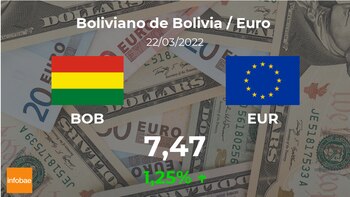
The euro is trading at the opening to 7.47 Bolivianos on average, which implied an increase of 1.25% compared to the previous day, when it stood at 7.38 Bolivianos on average.
If we consider the data for the last seven days, the euro accumulates a rise of 2.08%; however, in year-on-year terms, it still accumulates a decline of 9.31%. If we compare the figure with previous days, it reverses the result of the previous day when it experienced a decrease of 0.36%, showing that it is unable to consolidate a clear trend recently. With reference to the volatility of the last week, it is 10.3%, which is visibly higher than the annual volatility figure (7.42%), therefore it shows greater changes than the general trend in value.
In the last year, the euro has reached a high of 7.76 Bolivianos on average, while its lowest level has been 7.28 Bolivianos on average. The euro is placed closer to its minimum than its maximum.
The Bolivian
Boliviano has been the legal tender of Bolivia since 1987 and is divided into 100 cents, formerly the Bolivian peso was used but it was replaced. The Central Bank of Bolivia is the body responsible for regulating the issuance of currency.
Today, coins of 10, 20 and 50 cents are in circulation, as well as 1, 2 and 5 Bolivianos. In 1988 a Bolivian was equivalent to one US dollar.
As for manufacturing, Bolivian currency stopped being minted and printed during colonial times due to a lack of political interest, which would eventually result in coins and banknotes being made abroad because of the low price that this implies. In 2013 they were still manufactured in countries such as the United Kingdom, France and Chile.
Regarding the economy, in 2014 Bolivia resorted to high public spending and increasing domestic credit to maintain its growth, but these decisions resulted in increased public debt and reduced international reserves.
As in other countries, the coronavirus pandemic severely affected Bolivia's economy, although inflation was not as high as in other Latin American nations, closing 2021 with 0.90 percent.
According to forecasts made this year by the World Bank, Bolivia will grow by only 3.7% by 2022, however, President Luis Arce has challenged these forecasts and assured that Gross Domestic Product (GDP) could grow by up to 6%.
Inaddition, the country closed 2021 with a trade surplus of $1.471 million, the first in the last six years, where annual negative balances were recorded in the balance. In addition to these conditions, unemployment has increased by 5.2 per cent.
Bolivia is also facing global efforts to move to clean energy, so these conditions will prompt one of the largest gas-exporting countries to seek alternatives.
Agencies
Últimas Noticias
Debanhi Escobar: they secured the motel where she was found lifeless in a cistern
Members of the Specialized Prosecutor's Office in Nuevo León secured the Nueva Castilla Motel as part of the investigations into the case

The oldest person in the world died at the age of 119
Kane Tanaka lived in Japan. She was born six months earlier than George Orwell, the same year that the Wright brothers first flew, and Marie Curie became the first woman to win a Nobel Prize

Macabre find in CDMX: they left a body bagged and tied in a taxi
The body was left in the back seats of the car. It was covered with black bags and tied with industrial tape
The eagles of America will face Manchester City in a duel of legends. Here are the details
The top Mexican football champion will play a match with Pep Guardiola's squad in the Lone Star Cup

Why is it good to bring dogs out to know the world when they are puppies
A so-called protection against the spread of diseases threatens the integral development of dogs




